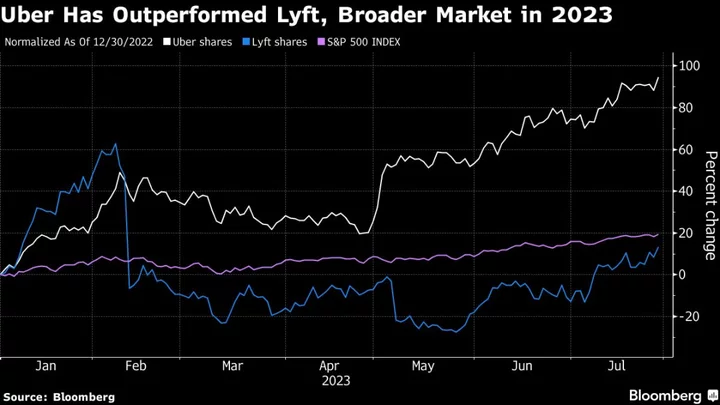Uber Technologies Inc. reported its first-ever operating profit, fueled by demand for rides and delivery and marking a significant milestone as the company seeks to move beyond its cash-burning past.
The results showed that trips in the US and Canada have recovered to pre-pandemic levels, while delivery demand hit an all-time high despite increased costs for food. Uber posted a second-quarter operating profit according to generally accepted accounting principles of $326 million and free-cash-flow of $1.14 billion. The shares rose 2.1% in premarket trading in New York.
“Both of these milestones were achieved through a combination of disciplined execution, record audience, and strong engagement,” Chief Executive Officer Dara Khosrowshahi said in prepared remarks. He added that the company was “well-positioned to sustain strong, incremental profit generation.”
Uber’s business has remained largely unscathed from elevated inflation rates as customers are still willing to pay a premium for the convenience of hailing a ride and getting food delivered to their door. After struggling with a driver shortage that caused fares and wait times to increase, Uber said the number of active drivers were up 33% in the second quarter compared with last year. The number of trips taken increased 26% from a year earlier to a record high.
Uber has focused on adding new features and products to the app, including a teen rides program, the ability to book group and guest rides, video gift messaging and a boat service. The company has also expanded advertising on the app and said it has been disciplined in cost management “across the board.”
The operating profit, the company’s first since its founding in 2009, helped push Uber to a surprising gain in net income in the quarter. Uber has previously reported a quarterly net profit on occasion but it has always been fueled largely from investment gains, as it was again in the second quarter. In the three months ended June 30, Uber generated net income of $394 million, far surpassing the loss of $49.2 million analysts were expecting.
Uber projected gross bookings of $34 billion to $35 billion in the current quarter and adjusted earnings before interest, tax, depreciation and amortization of $975 million to $1 billion, both beating analysts’ forecasts.
The company also announced that Chief Financial Officer Nelson Chai is stepping down effective Jan. 5, marking one of the most high-profile departures since the company went public in 2019. A search for his replacement is underway.
“When I joined the company in 2018, Dara asked me to lead the financial transformation of the company,” Chai said in a statement. “As you can see from our Q2 results, that transformation has occurred. I am very proud of the great work we have all accomplished and thank Dara for his partnership.”
San Francisco-based Uber shares have doubled in the last year, a stark divergence in performance from Lyft Inc., which has struggled to fully recover from the effects of Covid-19. Unlike Uber, Lyft only operates in North America and doesn’t have a food-delivery unit. Earlier this year, Uber’s crosstown rival installed a new chief executive officer and lowered prices to stem market share losses to Uber. Uber accounted for 74% of the US consumer ride-share sales at the end of June, while Lyft had 26%, according to Bloomberg Second Measure. Lyft shares slid less than 1% in premarket trading. The company is scheduled to report results next week.
When the pandemic crushed demand for rides, Uber’s decision to focus on Uber Eats helped it gain a foothold in the meal delivery sector which has continued to grow, even as indoor dining has resumed. Uber Eats generated $3.06 billion in revenue, slightly below Wall Street’s estimates, but better-than-expected adjusted Ebitda of $329 million as the unit benefitted from advertising. Customers seem to have been undeterred by higher prices for food, with delivery frequency of four monthly orders per eater, up 8% from a year earlier.
Total revenue jumped 14% to $9.2 billion during the period, the company said in a statement Tuesday. That narrowly missed the $9.3 billion analysts were expecting, according to data compiled by Bloomberg.
Uber generated $33.6 billion in gross bookings, which include ride hailing, food delivery and freight. That was up 16% from a year earlier and beat the $33.5 billion Wall Street had forecast.
Uber’s freight unit dragged on the company’s overall results. The division, which accounts for less than a quarter of total revenue, saw bookings and sales tumble 30% in the quarter. Uber said the unit is pressured by “category-wide headwinds,” with spot rates seasonally weak, a trend it expects to continue in the near term.

